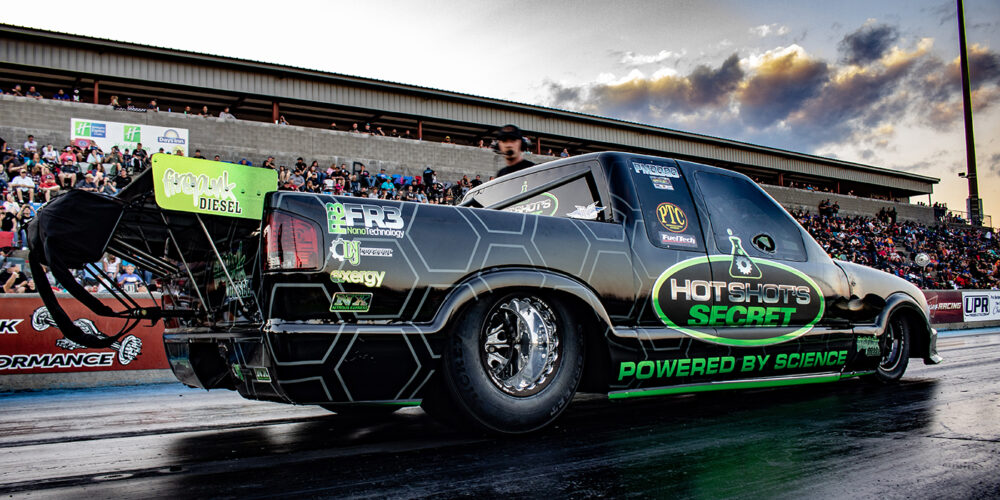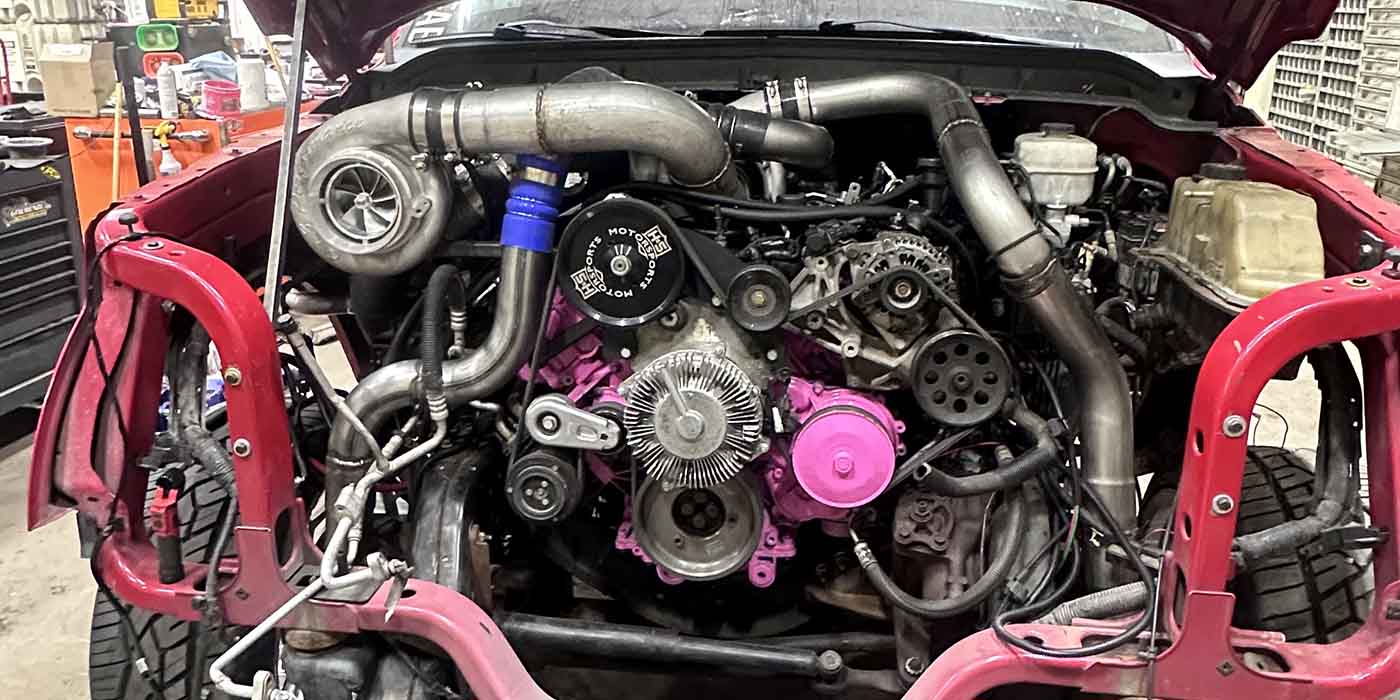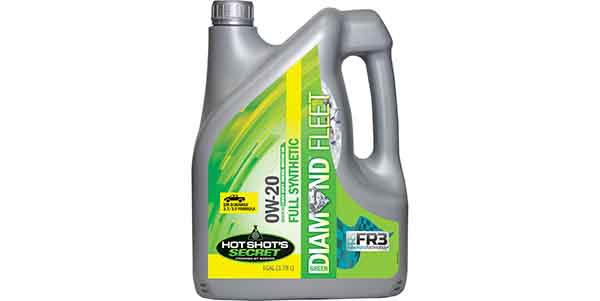To think diesel-powered race cars and trucks would be competitive or even beating gas-powered cars, at one time, seemed unfathomable, but here we are. It’s a reality, and the gap in performance is getting smaller by the day.
To get an overview of Pro Mod Diesel and to dive into the inner workings of a team at the leading edge of Pro Mod Diesel competition, we spoke with Lavon Miller of Firepunk Diesel and got the details of what it has taken over the last several years to do what was previously viewed as improbable, but not impossible.
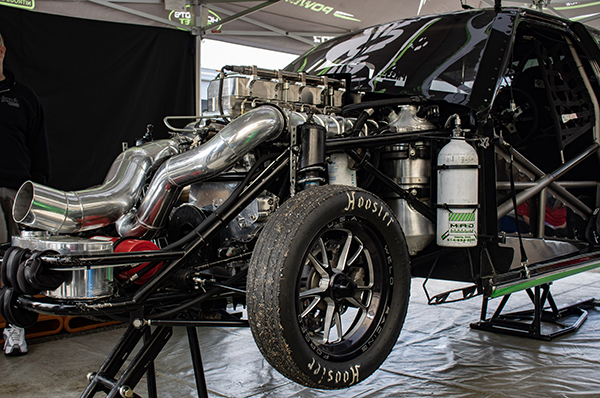
Lavon and Firepunk started this journey with a stock 2006 truck running in Pro Street. However, they quickly found themselves up against restrictions and a lot of broken parts. The progression to Pro Mod was almost a necessity.
“The progression to Pro Mod was because we got to the point where we were tired of always tearing stuff up and being restricted in our times because of our weight,” Miller says. “The NHRA would not give us a certification faster than a 7.99 in the quarter, or a 5.00 in the eighth to run at the weight that we were at 4,500-lbs.
“We had run a 4.97 in qualifying, but they had to throw the run out because we were outside of our cert. That was kind of what motivated our team at Firepunk. We wanted a 7.88, we wanted a 4.97. We were motivated to go faster, find new barriers and take diesel power to the next level. That’s where we started looking at the next class, which was Pro Mod.
“In Pro Mod, there’s no limit on weight restrictions, no power restrictions, it’s just you got a vehicle with doors – put an engine in it and go race. That was how our transition and mindset went to Pro Mod. It wasn’t a mindset of trying to go catch the gas world as much as we were trying to push the diesel industry forward.”
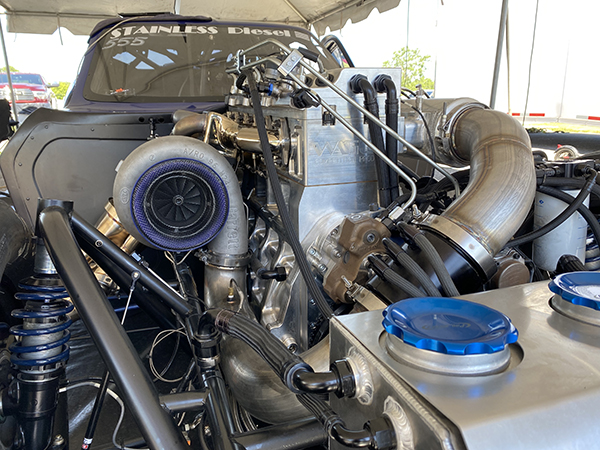
Pro Modified has become one of the quickest growing drag racing segments, however, when Firepunk began to explore a Pro Mod diesel, they were among only a few trying to advance that class in the diesel world.
“There was only a few of us out there, and those were teams doing well, but they also didn’t have a lot of competition at their level,” Miller says. “Therefore, there wasn’t much innovation happening to go to the next level for them because they were already at the top running high 4-second passes in the Pro Mod class. All it takes is a couple teams to come in and start knocking those barriers down. Then, the team that was stuck at the high-4s all of a sudden makes the push to go to mid-4s and then bottom-4s. Competition drives innovation and we all drive each other. I know it works for us. As soon as somebody comes out and runs with us, we are doing everything we can to figure out what we need to do to go to the next level.”
To get to that next level for Firepunk, from running 5.00-second ETs to low-4s, would take horsepower and less weight.
“The difference is about 1,200 horsepower, maybe more than that,” Miller laughs. “If you take a Pro Modified vehicle that weighs 3,200-lbs., that’s a heavy Pro Mod by today’s standards. Some of the nitrous cars are 2,350-lbs. with the driver in the Pro Mod class. A lot of the screw blown cars are 2,750-2,800-lbs. When we first put the S10 together in Pro Mod, we were 3,450-lbs., and that was still with a cast Cummins engine. We ran a 4.47, I believe, in 2018, which is the first year we debuted in Pro Mod. To us, the difference was we were able to make laps without tearing up the drivetrain.
“The transmission actually went 100 passes and we weren’t putting so much load on the engine that we were tearing up valves and all this stuff because it didn’t take as much horsepower as it did in the Pro Street class to run a lot slower time because we were that much lighter (more than 1,000-lbs).
“We were also learning how to work the chassis of a two-wheel-drive truck, how the weight transfer works, how the four link works – we were learning all these things. It was really fun to make a pass and your job between rounds was to make sure there’s no leaks, fill the fuel, pack the parachutes, and then study the data, figure out where you want to put the power curve at for your next lap, what chassis adjustments do you want to make, any bar changes or preload changes, wheelie bar changes, tire pressure changes. As a team, the racing part of it became a lot more fun because in Pro Street when we were at 4,500-lbs., it seemed like every other pass we were laying wrenches on the truck trying to fix something that we tore up because we were so heavy and we were really hard on parts.”
Aside from moving to a better chassis and the S10 body, Firepunk also worked closely with Drew Pumphrey and the guys at D&J Precision Machine in Cambridge, OH to build a better 6.7L Cummins engine.
“I think Drew had close to 400 hours in building that first engine,” Miller says. “The main thing that started this is when we split the block on the engine dyno back in fall of 2017. Drew wanted to help us build a better platform, so he built the short block with a lot more meat around the mains, and then he has a whole tool steel bed plate that fastens to the aluminum block. Instead of having individual main caps, the whole lower 3” of the engine is a bed plate, which also has the mains in it. Each main has six 5/8ths studs in it. You have a total of 42 main studs clamping this bed plate to the block. I think it’s calculated at about 1,000,000-lbs. of clamping force. We don’t have any problems with the mains walking at all. It’s overbuilt.
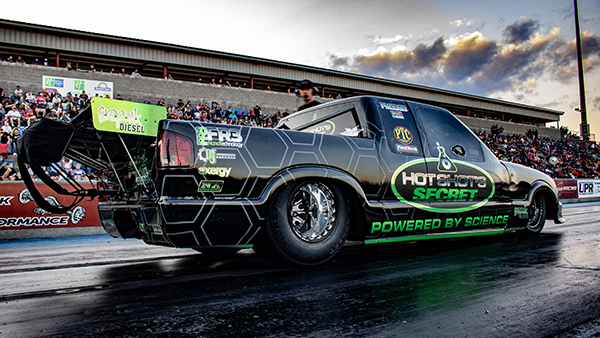
“Also, the overall frame of the block is a little bit wider, so there’s more meat around the edges on the outside of the sleeves. We have vertical strength because with an inline six, obviously it tries to separate. It tries to blow the crank out the bottom or blow the head off the top. With the extra width, we are able to get more main webbing, more strength, less twist, and more reinforcement for the sleeves. It’s the same with the head studs. He had to do a little work with getting the head stud designed to where the aluminum can grow. With the aluminum engine you end up having to pull the valve cover more often to double check valve lash and make sure you’re doing all right. The aluminum has its advantages because it’s so much lighter, but it creates more maintenance.
“The other thing Drew did with the head was he figured out he could gain almost 100 cfm of exhaust flow by putting one exhaust port per valve on the exhaust side. Our exhaust has 12 exhaust ports instead of just six. It has bigger valves in it, and as we keep increasing the horsepower, cylinder pressure goes up, which puts more pressure on the valves and you’re more likely to tulip a valve. We keep working with Ferrea on getting a better valve made. You’re always chasing that next level, but we’ve made so many progressions on it that it continuously gets better.”
According to Lavon, everybody running at the top of the Pro Modified Diesel class is running a Cummins platform. However, some of the V8 options aren’t far behind.
“Other guys we’re racing with like Ben Shadday and Johnny Gilbert are both using the Cummins platform like we are,” he says. “However, the Hollyrock crew has a Duramax platform in their rail, and they went 3.96. They’re 2,200-lbs., so they’re about 800-lbs. lighter than what the S10 is. They can run that same time with probably 600-700 horsepower less. The Duramax platform, being a V8, is probably a better model for a high-rpm power curve. In Pro Mod, the more useful rpm power curve we have, the better we can use our power management.
“You also have Rudy’s using a Powerstroke platform and they’ve been somewhere around 4.48. I feel like the V8 platform right now would probably be capable of doing it if you’d have somebody put the same amount of time and efforts that we’ve been putting into the Cummins platform. But I feel the Cummins platform is further ahead as far as actually holding up at 3,000 horsepower right now.
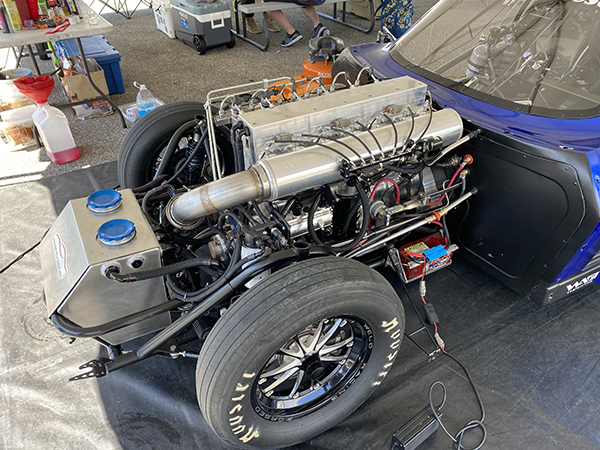
“If you’d make 3,000 horsepower with the Duramax platform, I feel there’s still barriers that haven’t been figured out yet, but I’m also not a Duramax guy. Jeremy Wagler will probably tell you something different. He actually expressed a little interest in buying the S10 and putting a Duramax in it and seeing what he could do with it. I would love to see what would happen.”
No matter the engine platform, seeking and breaking new barriers always comes with hurdles to overcome, and the Firepunk team has gotten good at hurdling.
“It seems every time you reach a barrier or pushing that new barrier, you find new weak points in your engine program,” Miller says. “In our second season, we ended up finding a good bit of weak links in the Turbo 400 transmission. Rossler hadn’t had anybody breaking input shafts or intermediates and we broke both. They had to design a new input shaft and a new intermediate shaft. Going to that next level means you find that next weak link and then you address that weak link and that can take anywhere from six months to a year to get dialed in. It’s amazing how fast it progresses with how long everything actually still takes to do.”
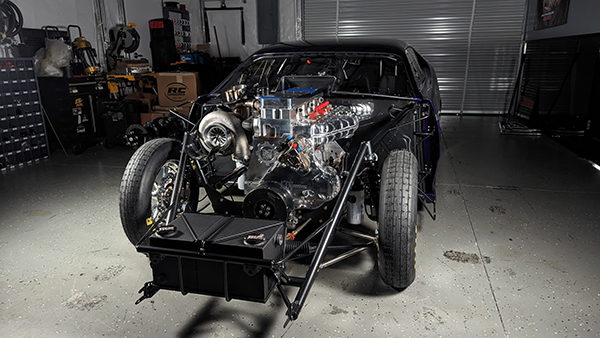
The biggest differences between what Firepunk was doing in Pro Street and what they’ve been doing in Pro Mod have been horsepower and weight. Obviously, that’s an oversimplification, but it does come down to those two elements and then dialing everything else in.
“The main difference is shedding that 1,500-lbs. gains you a whole second with the same horsepower,” he says. “When we first started racing Pro Street, you have a truck that can make 2,000 horsepower. You go launch the truck and as soon as the boost ramp comes to full boost, you’ve got full power and you’re making your pass. As you get faster, now you have to manage that power because we can have 3,200 horsepower, but I can’t use that until I’m 2.8 seconds into the run or else I’m knocking the tires off. While your peak power has gone up significantly, the amount of time into the run until you can use that peak power continues to move out. That’s why we’re building a new chassis. We got to the point in the S10 where we felt like we couldn’t progress much more in our 330-foot time.
“Regardless of what we did with the suspension, we were stuck in this range that we couldn’t get past that barrier. We’re building a new chassis that is going to be 300-lbs. less and it’s going to be set up directly for the Cummins powerplant. We’re hoping it’ll weight transfer better and be able to decrease our short track times, so that we can get to peak power by 1.8 seconds or even 1.5 seconds. Now, we’ll have a chassis that we can utilize that power and be putting full load on the engine for an extra second, second and a half on every pass, and we’ll probably find new problems with the engine that we didn’t have before. That’s how progression goes.
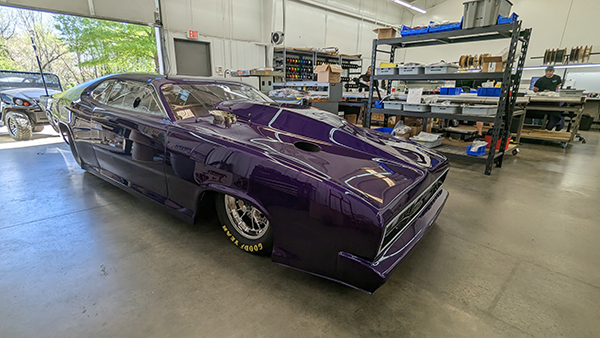
“It really is pretty simple as far as weight versus horsepower. However, what we didn’t calculate is that we couldn’t use that 3,000 horsepower right off the line. It takes a lot of knowledge and a good chassis to be able to use that 3,000 horsepower the majority of your run. You can have all the power in the world, but as soon as you get it to peak power and it knocks the tires off, you’re not going fast. That’s the goal that I’m hoping we’ll see with this new chassis.”
Firepunk has tapped the knowledge of Reese Brothers Race Cars to build the new chassis. The team is also going to a five-speed Liberty transmission so they can run the taller rear gear they need to be able to run 200 mph, but still get the starting line ratio low enough to match what a lot of the gas Pro Mod cars would run. They’re also implementing a new Bosch ECM.
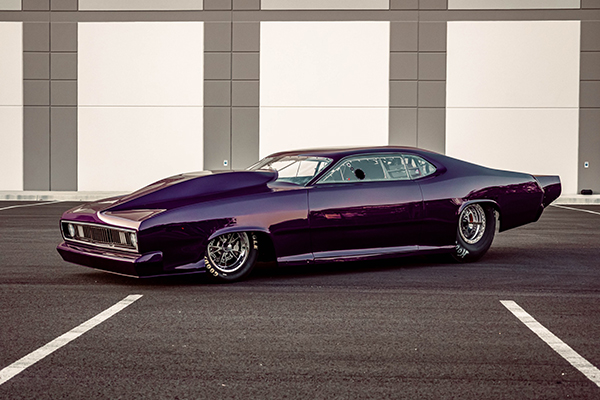
“I’m really excited to see what this summer holds,” Miller says. “I know a new car always has bugs to work out, but our goals are big numbers. The goal five years from now is to be able to run high 3.60s, like a 3.68 at 200 mph would be the goal. Obviously, if we can do that sooner, that’d be great. But, I feel like there’s quite a bit of barriers we’re going to cross every .010-second we knock down.
“We know it can run a 3.90, but if you want to run a 3.68 at 200 mph, you’re going to need 4,000-plus horsepower. We’re not there… yet.” EB

